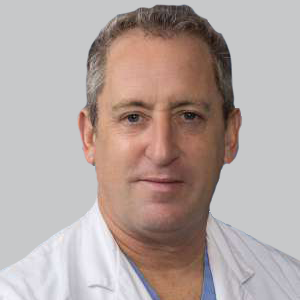News
Article
Insights on UCB’s Commitment to Advancing Rare Epilepsy Care
Author(s):
Key Takeaways
- Advances in antiepileptic drugs, like fenfluramine, have improved outcomes for treatment-resistant epilepsy, particularly in Dravet and Lennox-Gastaut syndromes.
- UCB's research at the 2024 AES Annual Meeting highlighted fenfluramine's efficacy and safety, supported by clinical and real-world data.
Brad Chapman, head of U.S Epilepsy and Rare Syndromes at UCB, provided context on some of the innovative research and studies being presented at the 2024 American Epilepsy Society Annual Meeting.
Brad Chapman

Epilepsy care and treatment have made significant strides over the past decade, transforming outcomes for many individuals living with this neurological condition. Advances in antiepileptic drugs have led to more targeted treatments with improved efficacy and safety profiles, reducing seizure frequency and improving quality of life for patients. Recently approved medications, such as fenfluramine (Fintepla; UCB) for Dravet syndrome (DS) and Lennox-Gastaut syndrome (LGS), represent breakthroughs in addressing treatment-resistant epilepsy.
At the 2024 American Epilepsy Society (AES) Annual Meeting, held December 6-10 in Los Angeles, California, UCB presented an array of abstracts from its epilepsy research program, covering clinical and real-world data, plus medical research from across UCB’s pipeline programs. For DS, highlights include analyses of fenfluramine's efficacy and safety, real-world evidence from a pharmacy database, and medication adjustments from the European early access program. LGS data include post-hoc analyses of fenfluramine treatment with and without vagus nerve stimulation, efficacy trajectories, adverse event profiles, and seizure outcomes based on baseline frequencies.
To learn more about UCB’s commitment to advancing care and science for epilepsy and rare syndromes, NeurologyLive® sat down with Brad Chapman, head U.S Epilepsy and Rare Syndromes at UCB. Chapman discussed more about the several presentations on fenfluramine and how its knowledge profile has expanded since its original approval. He also discussed addressing unmet needs for women of childbearing age through initiatives like the CONCEPTION project and partnerships with the National Institutes of Health to reduce uncertainty around medication use during pregnancy and breastfeeding.
NeurologyLive: What are you most excited about at AES? And why talk about some of the data and the things going on here?
Brad Chapman: There's really a lot to be excited about, so it's hard to pick just one area. But I'm definitely excited about the scientific innovation on display here at the AES annual meeting. When I think about the 30-plus scientific abstracts presented, they truly reinforce our commitment to this community and to advancing science for patient care. Specifically, when we think about those living with epilepsy or rare syndromes like Dravet syndrome and LGS, the data presented here is incredibly meaningful.
I'm particularly excited about the data focused on women of childbearing age. Addressing the unique needs of this population is crucial, and we've taken the time to understand what information is most relevant for them—using tools like social listening to better comprehend their experiences. Additionally, there’s exciting data on fenfluramine for seizures associated with Dravet syndrome and LGS, as well as broader developmental and epileptic encephalopathies.
At this year’s AES conference and in general, how is UCB demonstrating its current collaborations and initiatives aimed at advancing care and science in epilepsy and rare syndromes?
When we take a step back and look at collaborations and partnerships, UCB is advancing care through the science on display. Whether it’s abstracts focused on patients, families, or the HCP community—or data for women of childbearing age—we’re using this information to guide current and future decisions.
One initiative we’re particularly excited about is CONCEPTION, a project funded by the Innovative Medicines Initiative. It’s focused on reducing uncertainty about the effects of medications during pregnancy and breastfeeding, helping women make more informed decisions about their treatment options. We’re also partnering with the National Institutes of Health on the Task Force on Research Specific to Pregnant and Lactating Women, which advises the Secretary of Health and Human Services on research gaps related to safe and effective therapies for these populations.
How has our understanding of fenfluramine grown since its approval?
It’s always encouraging to engage with healthcare professionals and families using fenfluramine, and we continue to see the profound impact it has on appropriate patients living with Dravet syndrome and LGS. This impact is reinforced through the data being showcased here at AES.
There are 16 abstracts at this year’s conference focused on fenfluramine, covering real-world evidence, evaluations of populations with DEEs, and support from clinical trial data, as well as global and U.S. post-marketing safety data. All of this underscores the promise that fenfluramine holds for patients living with rare and debilitating forms of epilepsy.
Any last thoughts regarding AES and the emerging science?
AES always provides a unique opportunity to reflect on what we’ve achieved and look ahead to what’s next. This year is no exception. I feel incredibly honored to be surrounded by such brilliant minds who share our commitment to improving the lives of people with epilepsy and rare syndromes.
For over 30 years, we’ve built a strong legacy in this space, and AES serves as a reminder of the progress we’ve made and the opportunities still ahead. With our existing portfolio and deep understanding of the patient experience, we’re constantly exploring new ways to improve care. The energy and engagement here set the tone for 2025 and beyond as we continue to reimagine how we can better support those impacted by epilepsy and rare syndromes.





